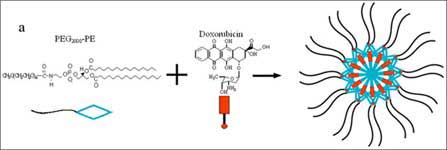| Posted: July 7, 2007 |
Nanoscale carrier delivers chemotherapy drug deeper into solid tumors |
|
(Nanowerk News) Chinese Academy of Sciences (CAS) researchers have developed a new drug delivery method using nano-sized molecules to carry the chemotherapy drug doxorubicin to tumors, improving the effectiveness of the drug in mice and increasing their survival time. Their work has been reported online on June 26 in the Journal of the National Cancer Institute.
|
|
In the past, similar drug carriers have improved targeted delivery of the drugs and reduced toxicity, but they sometimes decreased the drugs' ability to kill the tumor cells. Using a new drug carrier, a research team led by LIANG Wei and HANG Haiying from the CAS Institute and Biophysics and their collaborators compared tumor growth and survival in mice that were given doxorubicin in the nanocarriers or on its own.
|
 |
Schematic illustration of self-assembly of doxorubicin and PEG-PE. (Image: CAS)
|
|
Doxorubicin delivered by nanocarriers was more effective in preventing tumor growth than free doxorubicin, and the mice receiving this treatment method lived longer and had fewer toxic side effects.
|
|
"Encapsulation of doxorubicin...increased its accumulation and penetration in tumors in terms of both the percentage of cells that were reached by the drug and the intracellular levels that were attained," the researchers write.
|
|
In an accompanying editorial, Dr. Matthew Dreher from the National Institutes of Health in Bethesda, Md., and Dr. Ashutosh Chilkoti from Duke University in Durham, N.C., discuss the future of drug delivery, which they think should focus on three important research areas--drug combinations, targeting, and integration. The study is a simple but effective demonstration of the benefits of integration of a drug with an appropriate carrier to yield a striking gain in efficacy, the authors write. "May the days of pharmacological missiles that miss their target and friendly fire that kills patients soon be over!"
|

